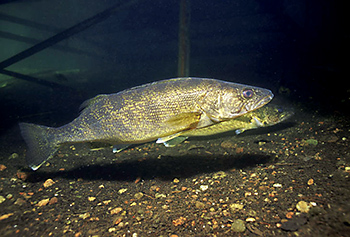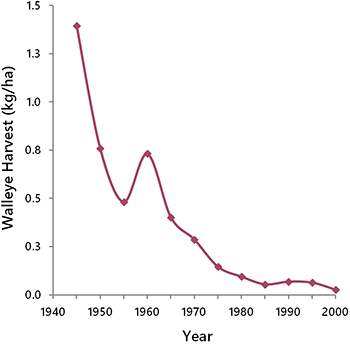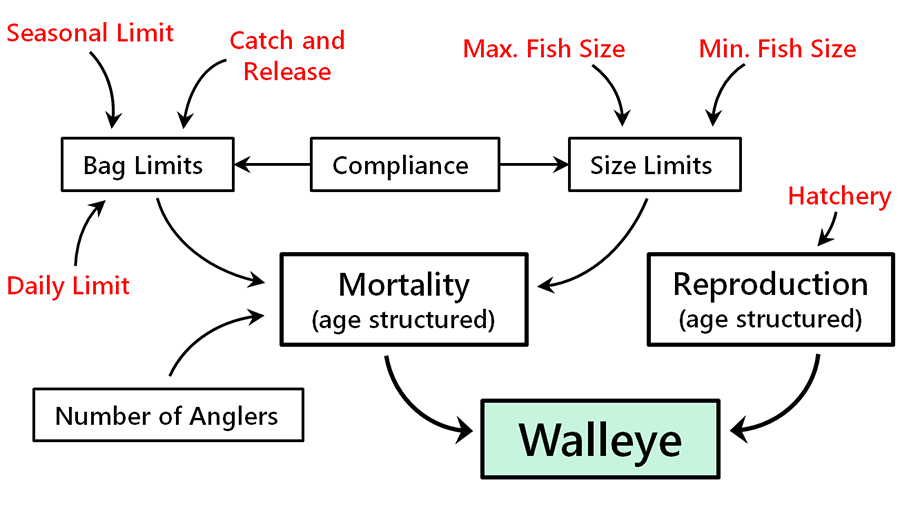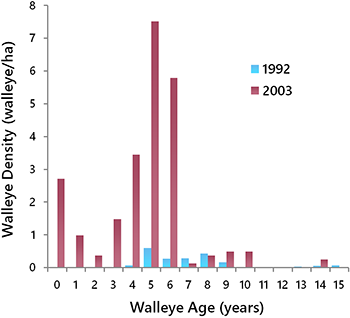Case Study 5: Walleye
Background

This case study examines the collapse and recovery of walleye from Alberta lakes (Fig. 11.23). The account is provided by Dr. Michael Sullivan, a fisheries scientist with the Alberta government who played a lead role in the recovery program.
A combination of factors makes Alberta’s lakes highly susceptible to overfishing (Sullivan 2003). Whereas many provinces have thousands of lakes, Alberta has only about 800 lakes that support sport fishing, and of these, only 177 contain walleye. Furthermore, fish grow slowly and mature late in Alberta because of the cold northern climate. Finally, walleye are more easily caught in Alberta than in northern US lakes because prey availability is low (Mogensen et al. 2013).

Alberta’s largest lakes were fished heavily for subsistence and dog food during the fur trade period, especially in the late 1800s. This was followed by intensive commercial fishing, which peaked in the early twentieth century. By the late twentieth century, walleye were nearly extirpated from Alberta’s large lakes (Fig. 11.24).
Smaller lakes were initially spared because they were less attractive to large commercial operators. These lakes later came under increasing pressure from sport fishing, as Alberta’s population, and the number of anglers, increased rapidly in the second half of the twentieth century (Pybus and Rowell 2005). Sales of angling licenses climbed from 122,000 in 1965 to 343,000 in 1986 (Sullivan 2003). Furthermore, the industrialization of Alberta’s north made most lakes in the province easily accessible. The effect of having a large number of anglers concentrated on a relatively small number of lakes was, in hindsight, predictable. By the 1980s, individual lakes with popular sport fisheries showed severe declines in sport fish populations, and the size and age structure of these populations were highly disrupted (Sullivan 2003). The loss of top predators led in turn to ecosystem disruption, through an explosion of prey species.
During the period of general collapse, many biologists in the provincial fisheries department did not realize or accept that a decline was occurring. Walleye populations in larger lakes had been collapsed for decades, and many biologists accepted this as the norm. Moreover, there was a strong and widespread belief among many biologists and anglers that sport angling had no detrimental effects. Reports of poor fishing in smaller lakes were attributed to a variety of causes, such as a decline in angler skills (“too many city anglers going to these lakes”), a sense that memories from older times were false, changing fish behaviour, and a belief that environmental conditions had changed. The lower catch rates measured in creel surveys were attributed to poor study design. As a result, lakes with walleye populations near extirpation were kept open to harvest.
By the late 1980s, anglers at traditionally good walleye fisheries were catching very little. Success rates were typically under 10% (i.e., 90% of anglers caught nothing). Angling licence sales were falling, and public complaints were rising. Some biologists, applying the then-new technique of computer modelling, proposed experimental harvest regulations involving fish size limits. These proposals and methods were met with considerable doubt and suspicion from senior biologists and fisheries bureaucrats. The outcome was more studies, but little action.
Recovery Planning
In the 1990s, stakeholders became more directly involved in walleye management, and there was also a new emphasis on evidence-based decision making. A key step was the construction of an age-structured population dynamics model, which synthesized knowledge gained through years of field studies (Fig. 11.25). Mortality was overwhelmingly caused by human harvesting, and this was the focal point of management interest. Four mortality variables were included in the model: the number of anglers, the mean harvest per angler, the age and size of fish taken, and the level of compliance with fishing regulations. The reproductive capacity of walleye was incorporated into the model as a set of fixed parameters. The model also included a set of management options linked to these core variables. Testing and refinement of the model were undertaken to ensure consistency with observed patterns.

Through their explorations, the biologists leading the modelling effort developed an understanding of the management changes needed to achieve walleye recovery. But they also knew that management by decree would not be successful. The imposition of new constraints on anglers was bound to set off protests and calls to the responsible minister. And while attitudes within the fisheries agency had begun to shift, senior management was still not convinced that the proposed management approach was appropriate.
To gain the support needed for implementing new recovery measures, the biologists held a series of stakeholder workshops in 1995 and 1996. The aim was to engage stakeholders in the decision-making process to help them understand the management options and the likely outcomes. It was hoped that a management approach could be identified that would have broad agreement among stakeholders and would be acceptable to senior management.
The biologists knew that careful selection of participants and structured facilitation of the workshops would be critical to making progress. Michael Sullivan describes the process that was used:
We needed to have groups of concerned and open-minded people attend the workshops. At meetings open to the general public, it’s common to attract a few highly vocal and opinionated individuals that dominate the discussion. This can make it difficult for everyone to be heard. Achieving openness while still ensuring fairness to all perspectives is a major challenge.
Our solution was to limit the workshops to approximately 15 people each. That seemed to be a number that was large enough to obtain diverse opinions but small enough to have meaningful conversations. We chose 20 meetings sites across the province, to allow the Minister to say that the process was not rural focused, or city focused, or aligned with special interests.
The individuals invited to each meeting were selected by local fisheries staff who were provided with a list of the types of stakeholders we were looking for. We asked for several sport anglers, several commercial operators, a local science teacher, a tackle store owner, a few retired people, a few young people, Indigenous people, the local Forestry official, Parks staff, and so on. We were looking for a range of perspectives. We wanted people who cared about the topic, but not just as anglers. We wanted people who might typically complain about the government and make them part of the process. We wanted people who would provide new viewpoints. We wanted diversity in knowledge, experience, opinions, and concerns. What we didn’t want was an echo chamber. Every consultation exercise needs to wrestle with this list.
Once the list of potential names had been assembled, invitations to participate in the workshop were sent out. We offered to pay their expenses (gas, hotel, meals). We showed, with real sincerity, that their participation was important to us and to Alberta’s fisheries. We treated them with respect, and as well-treated and good people do, they responded in kind.
Each workshop started with dinner. People are less likely to argue with someone they have just shared a meal with. After coffee and dessert, a presentation on the state of Alberta’s fisheries was given and then a game was played to help the audience understand the process of modelling. In this loud and fun game, which simulated a fishery, people took turns drawing paper “fish” out of a cardboard box until none were left.
Each person drew a given number of fish based on realistic Alberta catch data. The size and fecundity of the paper fish also followed actual Alberta fisheries data. We then showed what it would take to maintain the stock, using different limits on harvest size and quantity. The point of this simple model was to get people to appreciate the cumulative effect of having many anglers catching a few fish. We also wanted them to understand the limitations of size limits, the minor influence of bag limits, and the overall complexity of management.
After the cardboard box game, we introduced the more complex computer model, which was run interactively and in real time. The input variables were displayed as “sliders” on a computer screen projected at the front of the room. The output was a time-series graph showing the predicted trajectory of the walleye population.
The initial runs were identical to the earlier game. Participants would soon say, “Heck, we already knew that bag limit wouldn’t do anything.” Then, we explored what might happen with a complex regulation. For example, we might ask if a 50 cm size limit, with a bag limit of two fish, non-compliance of 20%, and a 30% increase in fishing pressure would achieve recovery. Soon, the participants wanted to try their own complex combinations. The key to the process was in allowing the participants to accept the model on their own terms and incorporate its output into their own decision making. The playing-with-regulations game often went on for hours.
At the workshops, stakeholders invariably had questions that extended beyond fishing regulations. What about shoreline habitat destruction? Are you going to kill cormorants? Why not just stock more fish? These questions had to be answered meaningfully. Yet, we also needed to keep the workshop focused on the main drivers of walleye population dynamics, which were related to fishing. Our approach was to prepare for such questions ahead of the meeting. When hot-topic issues arose at the workshops, we generally had variables in the model, supported by field data, that allowed participants to explore them and then put them to rest.
At the end of the series of walleye workshops, the vast majority of participants had selected regulations that were based on good science, were simple to follow and enforce, and promoted fisheries recovery in a reasonable length of time. Approximately 80% of walleye lakes were recommended for catch-and-release fishing until recovered; 10% were classified as vulnerable, and only large fish could be kept; and 10% were classified as stable and received a broader harvest-size limit.

The Minister responsible for fisheries whole-heartedly accepted the workshop recommendations and they were implemented in 1996. Within a few years, signs of recovery were obvious. Catch rates climbed and the sizes and ages of walleye increased (Fig. 11.26). Eventually, fishing became better than most anglers, or even their grandparents, ever remembered. Now, in 2018, fishing for walleye within an hour’s drive of Alberta’s largest cities is better than it was in remote fly-in lakes in the 1980s and 1990s.
Analysis and Conclusions
In this case study, the various components of the decision-making process were tackled by different groups of people at different points in time. Like the Al-Pac case study, the elements of structured decision making were all present, but the process stretched out over many years.
The critical step of defining objectives evolved slowly and was linked to changing attitudes within the provincial fisheries agency. Senior biologists had come to accept low walleye populations as the norm, and from their perspective, there was no pressing problem that needed to be solved. This was an example of the shifting baseline syndrome in action (Pauly 1995). Agency culture was also a factor. Information was filtered and judgments were coloured by long-standing institutional norms. Change finally occurred when a new cohort of biologists brought fresh ideas, perspectives, and methods to the agency. With support from stakeholders, this group eventually prevailed, and walleye recovery, rather than maintaining the status quo, became the focus of management.
The decision-making process was divided into two distinct phases. The first phase was science based and was handled internally by a core group of biologists. It emphasized quantitative research and the development of a walleye population model. This phase provided the information and structure used in later stages of the decision-making process. In effect, the computer model served as a digital version of the consequence table described in Chapter 10.
The second phase emphasized social decision making and centred on a series of stakeholder workshops. At these workshops, little time was spent discussing the objectives, identifying management levers, or searching for the best available information. All of these aspects were directly imported from the first phase of the decision-making process. The stakeholder groups focused on exploring the outcomes of management alternatives and choosing the best option.
The robust approach to decision-making used in this case study was a major contributor to the success that was achieved. The development of a solid scientific foundation was vital, in that it enabled evidence-based decision making. Furthermore, planning efforts were not limited to the identification of threats and the listing of management options—a shortcoming of many recovery plans. Instead, the process was carried through to implementation, and considerable effort was devoted to the social dimension of decision making. This was vital for gaining a broad base of support for management changes. The biologists leading the process recognized that much would depend on trust, which had to be earned, and that the personalities of the participants would make a big difference.
Several intrinsic features of the management problem also contributed to the successful outcome. The walleye system was relatively simple and self-contained, with few confounding factors. Moreover, the main threat—overfishing—fell within the purview of the biologists responsible for managing the species. Finally, and perhaps most importantly, the long-term interests of anglers and walleye were fundamentally aligned. The more fish, the better the fishing experience. The main trade-offs were temporal. Anglers had to forgo some fishing opportunities today to benefit from greater opportunities in the future.
A later effort to apply the same planning techniques at the regional scale, for the recovery of several species at risk in the eastern slopes of the Rocky Mountains, met with less success (GOA 2017b). The process again began with scientific study and the development of population models. In this case, there were additional drivers in the system, besides fishing, that had to be incorporated, such as industrial development and invasive species. This meant that decision making was more complex and involved more stakeholders. It also meant that fisheries biologists no longer had authority over all the relevant management levers.
In the end, the process was derailed by opposition from the Alberta Fish and Game Association (AFGA) and its supporters. Though the fisheries biologists had conducted extensive outreach and held many workshops in support of the initiative, AFGA was resolutely opposed. AFGA’s position was that anglers should not have to bear the cost, through reduced fishing opportunities, of habitat degradation arising from industrial development (AFGA 2018):
Managers have not used all the tools available to them, particularly those that deal with habitat. … The Alberta Fish and Game Association cannot support the direction envisioned which relies primarily on angling regulations. … The plan does not appear to apply to industry, agriculture, infrastructure or urbanization other than assessing their impact on habitat. (pp. 3–4)
In support of its position, AFGA conducted its own outreach, mainly to its membership, and directed a lobbying effort targeting elected officials. The fisheries biologists countered with their successful track record in recovering walleye and assurances that the other species could be also recovered using the proposed measures. They also conducted opinion surveys that demonstrated strong public support for their earlier recovery-related efforts (GOA 2018b). Nevertheless, once the issue became politicized, the Minister balked. Instead of implementing the proposed recovery plan for the eastern slopes region in 2018, as scheduled, the Minister halted the process, stating that she “wasn’t convinced the science was strong enough” (Rieger 2018), even though trade-offs among conflicting objectives were the fundamental issue and not the science.
We see here the political power that organized groups can wield (i.e., the “squeaky wheel” effect). A more general lesson is that the scale of planning is an important factor in determining conservation outcomes. In this case study, shifting from individual lakes to a broad region brought more stakeholders, more conflicting objectives, and a higher political profile. Arguably, it was this added complexity that was the fundamental barrier to success.

